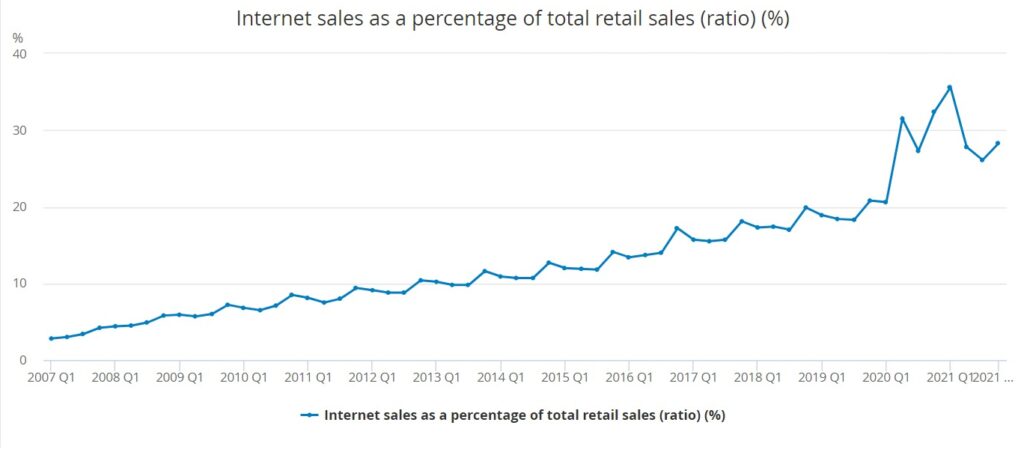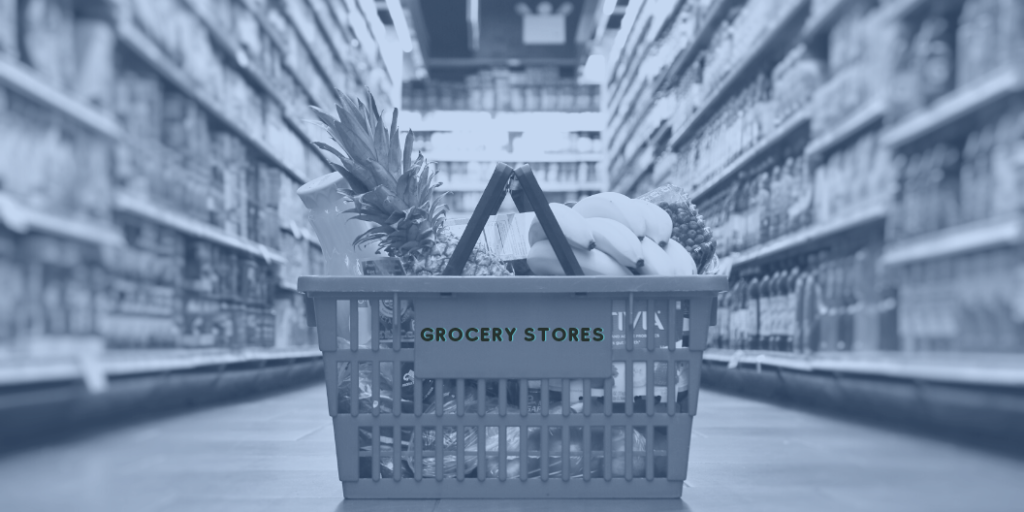Brick and mortar retail has been on the decline since the global financial crisis in 2008. Retail hit a 35-year low as people stopped shopping, and retailers started to discount items to achieve their bottom line. When you combine that with the growth in e-commerce, consumers have become accustomed to finding the best deal for products and are a completely different proposition than ten years ago.
The pandemic has exacerbated the trend that was already underway. The dramatic rise in e-commerce due to the onset of Covid-19 saw an increase in online retail sales’ share of overall retail sales from 16% to 19% during 2020.
As the high street begins to open fully in most countries, businesses are looking to take their first steps towards normality as 2022 draws closer. However, the economy is succinctly different to how it was pre-pandemic, and there are several lessons to take heed of.
The recovery of Brick & Mortar retail
The easing of restrictions means some of the trends towards online retail have begun to ease. For example, in the UK, June 2021 witnessed a considerable drop in online sales as a percentage of overall retail, where people started heading back to the high street.

Source: Office for National Statistics
Consumer spending on the high street is on the rise, and e-commerce is coming back down to expected levels. However, the transformation towards digital channels from before the pandemic still remains, and there is still limited travel, supply disruption, closures, and rising inflation to consider. Local high street stores are faring better than those in city centers and shopping centers. The main reason for the trend is the introduction of hybrid working models, with many workers staying at home rather than commuting.
In 2022, the move towards online shopping will continue, and for brick-and-mortar stores to be successful, they need to find ways of forming a hybrid offline/online model. For small businesses, face-to-face is still the most common method of engaging with customers. Still, many developed an online presence during the pandemic to adapt to the rapidly changing situation. The adoption of digital channels in 2022 complements the physical presence, rather than replacing it.
The impact of inflation on retailers
Inflation fears have resurfaced after a decade of subdued price increases, as the costs of many products and services have increased this year. The ongoing pandemic has played a major part in the rise in inflation since persistent COVID-related supply chain disruptions have rendered some commodities harder to come by, driving up consumer costs.
Inflation normally rises after a slump as demand outpaces supply early in the recovery, but COVID-19 effects have exacerbated this trend. As more COVID cases resulted in government limitations on consumer behavior, demand for various commodities fell in 2020 and stayed lower into 2021.
Since inflation increases inventory costs, businesses need to develop new purchase strategies to minimize future price spikes. They need to predict the right time to replenish supply while avoiding costs spikes that will affect their margins. Outdated methods of manually analyzing multiple data sources with spreadsheets can’t handle the fast, complicated calculations needed for such a challenge. Most of all, the old ways can’t cope with the automatic and quick response times required to shield sellers from rising inflation.
Deploying an agile pricing solution becomes necessary to automate, optimize, and manage prices in an inflationary environment. But the threat can also serve as an opportunity. The risk of increasing supply replenishment costs may push some sellers to “sit” on parts of their inventory, waiting for real selling prices to rise. Sellers can award higher prices to their commodities, temporarily driving sales down while waiting for buyer demand to catch up. Thus, saving enough inventory to sell at higher prices and shielding themselves, at least partly, from shrinking margins due to rising procurement costs.
The top considerations for retail moving into 2022
Fluctuations in demand
Where there are red zone markets, most retail outlets closed their doors bar grocery and pharmacy stores. While that meant a reduction in demand for some as consumers shifted channels, the grocery industry, in particular, was left to deal with significant spikes in demand. While adapting their business models and strategies to the “new normal”, retail stores need to find a way to predict and manage demand and avoid out-of-stock or excess stock situations.
Supply chain challenges and inventory management
The explosive increase in demand led to many companies expanding their capacity. Where some products such as toilet paper, cleaning items, food, and home entertainment were highly sought after, retailers could see that as an opportunity to gain profit through price gouging. However, there are legal implications to these practices and retailers should pay more attention to stabilizing their supply chains. Multiple lockdowns restricted or stopped the flow of goods for a considerable period, bringing to light existing vulnerabilities in supply chain management.
Two fundamental areas that these considerations impact are inventory management and your ongoing business pricing strategy.
As soon as one part of the supply chain breaks down, it impacts everyone along its journey. The pandemic shows that companies need to emphasize inventory management at every stage and not only on the bottom-line savings. Lockdowns and restricted cross-border movements, stopping the flow of goods. A lack of supply chain visibility, which can often cover tens or hundreds of stakeholders, meant companies were severely disrupted and could not meet consumer demand.
There is already a shift towards a more integrated network than the linear supply chains prevalent pre-Covid-19. Investment in artificial intelligence (AI) and Internet of Things (IoT) technology that provides vital data on goods within the chain is becoming a top priority for senior executives. The future of supply chains is digitization to improve the visibility of the retail network.
A digital, more intelligent, and more dynamic supply chain allows retailers to react quickly to disruptions and match supply to demand. A real-time inventory view across all locations, stores, and transits can enable retailers to identify any potential mismatches and failures. Modern inventory management solutions can alert users about stock and offer recommendations around reallocating inventory.
Adding AI to the order management and fulfilment process allows retailers to optimize the inventory and ensure they use it at its most profitable price point. Where AI constantly learns from data, it will incrementally improve the outcomes. Retailers can ensure demand is met in the most profitable way at all times.
Omnichannel
Retailers must now integrate these digital and physical experiences in order to meet customers where they are. If a customer is reading through Google Shopping on their phone while watching TV, it should be simple for them to discover the thing they want, order it, pay for it, and have it delivered when they want it.
Retailers who haven’t yet polished their omnichannel marketing efforts to make this buyer’s trip easier risk losing that shopper to another retailer.
Retailers are expected to provide customers with a personalized shopping experience from beginning to end. Retailers who use the correct omnichannel approach to match these expectations will be well-positioned for long-term success.
New approach to Pricing Strategies
It’s common for business owners and executives to undervalue the importance of pricing. They frequently examine the costs of their products, compare them to those of their competitors, and adjust the selling price by a few dollars. Costs and rivals are crucial, but they should not be the focus of a pricing strategy. Profit and revenue are maximized with the optimal pricing plan.
Traditional mathematical approaches cannot fully represent the intricacies of today’s competitive market. Implementing and maintaining successful pricing strategies is difficult due to the need to react in real-time and factor in many data sources and economic variables such as geographies, currencies, and regulatory requirements.
Many internal and external aspects are considered in holistic pricing schemes. Revenue goals, marketing objectives, target audience, brand positioning, and product qualities are all considered internally. Consumer demand, rival pricing, and market and economic trends all influence pricing methods from the outside.
Retailers must utilize pricing techniques to attract customers in a highly competitive environment. Unlike traditional pricing techniques (such as cost-plus pricing, value-based pricing, and inventory-sensitive pricing), dynamic pricing and optimization allow merchants to create more complicated pricing strategies that align and support the company goals.
Pricing managers need to analyze multiple data sources across a multichannel environment. Often, manual processes only allow them to support decisions for 5%-15% of their catalog. Covid-19 has created the need for more agile and resilient organizations, and digital transformation is at the forefront of the race towards Industry 4.0.
Summary
The Covid-19 pandemic has had a significant impact on retail and is set to continue going into 2022. While the market remains dynamic and uncertain, retailers must look towards new strategies and technology to stay competitive. Smart retailers are acting accordingly by thinking about all the scenarios and planning for the potential long-term social, economic, and health consequences of the virus.








